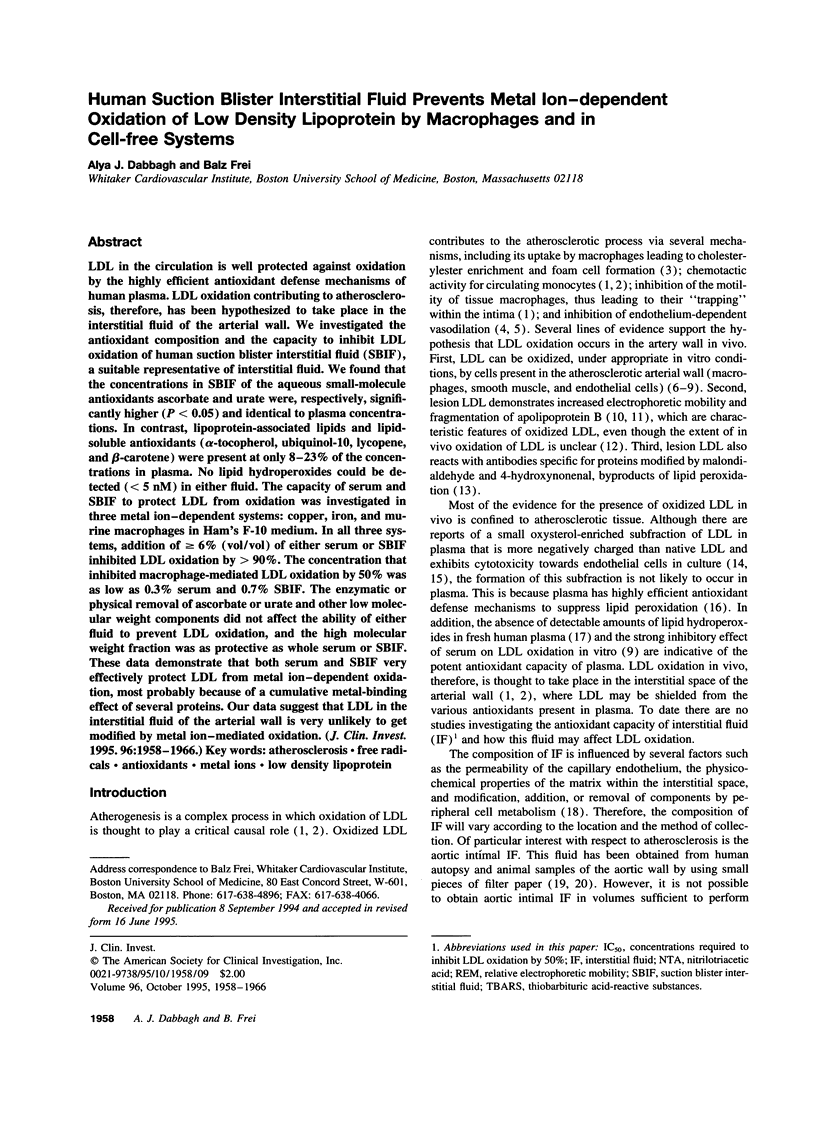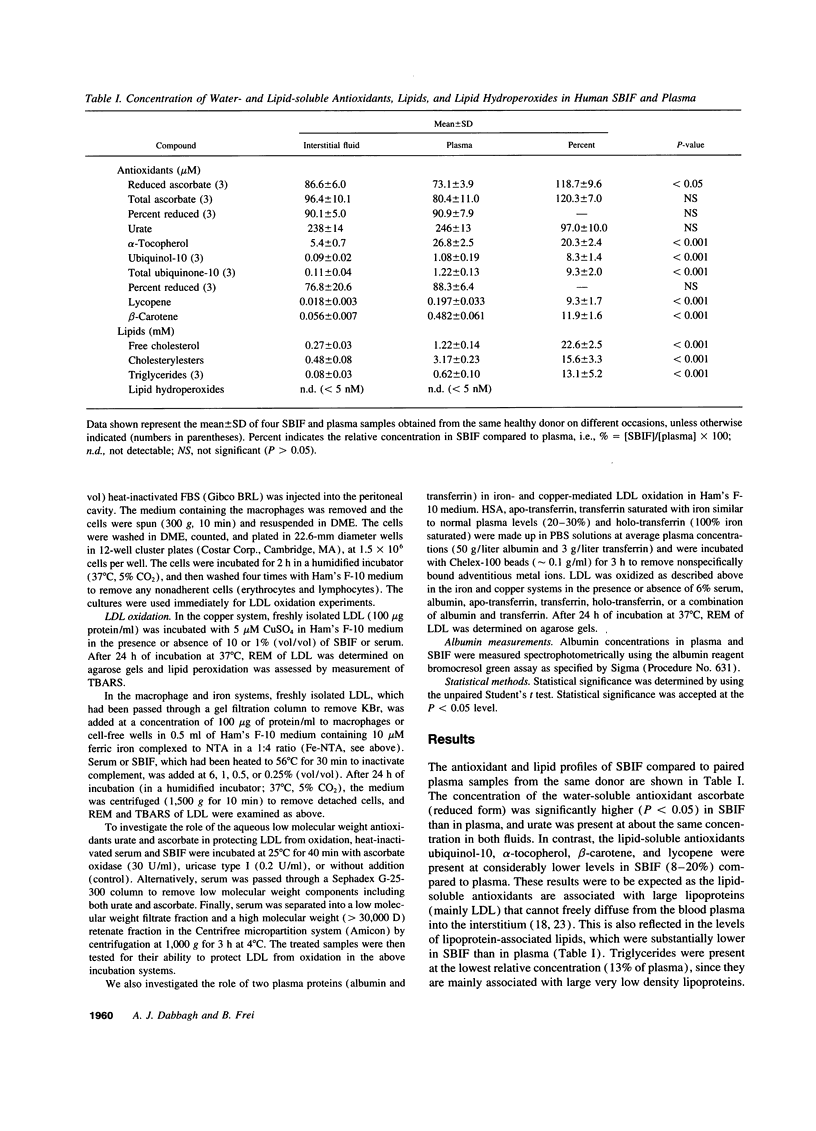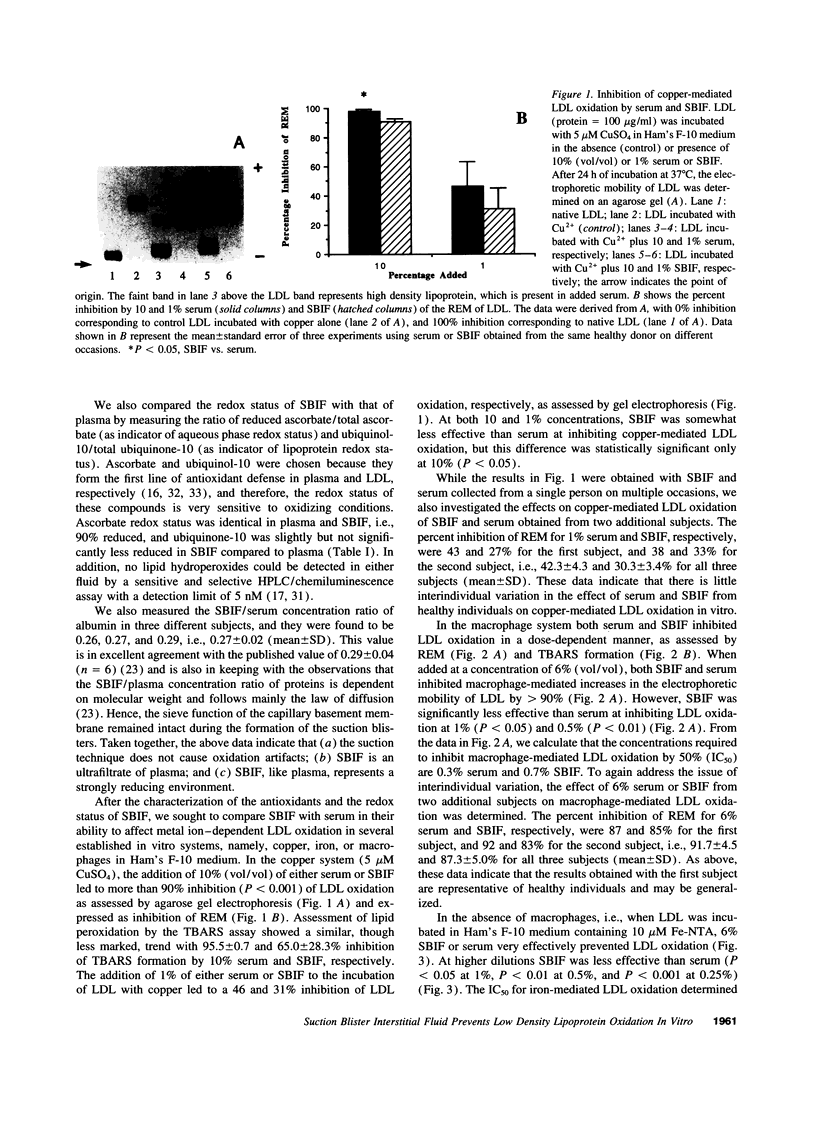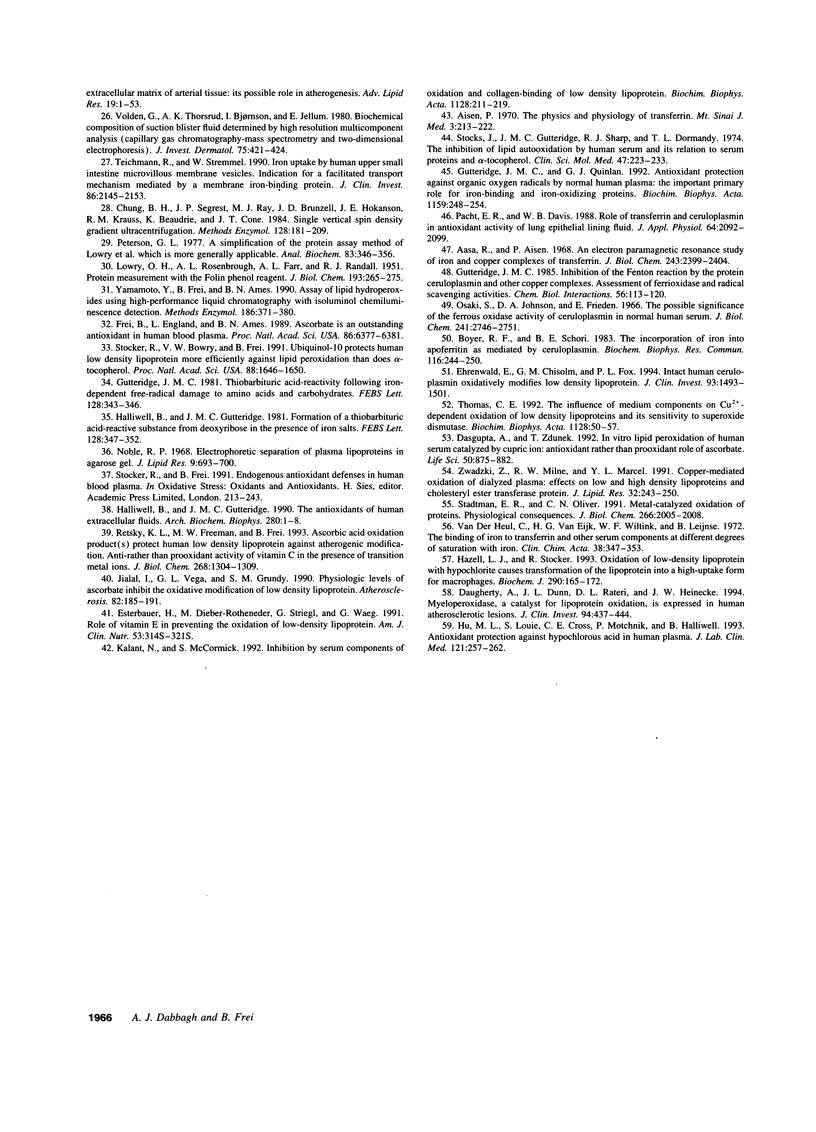Abstract
LDL in the circulation is well protected against oxidation by the highly efficient antioxidant defense mechanisms of human plasma. LDL oxidation contributing to atherosclerosis, therefore, has been hypothesized to take place in the interstitial fluid of the arterial wall. We investigated the antioxidant composition and the capacity to inhibit LDL oxidation of human suction blister interstitial fluid (SBIF), a suitable representative of interstitial fluid. We found that the concentrations in SBIF of the aqueous small-molecule antioxidants ascorbate and urate were, respectively, significantly higher (P < 0.05) and identical to plasma concentrations. In contrast, lipoprotein-associated lipids and lipid-soluble antioxidants (alpha-tocopherol, ubiquinol-10, lycopene, and beta-carotene) were present at only 8-23% of the concentrations in plasma. No lipid hydroperoxides could be detected ( < 5 nM) in either fluid. The capacity of serum and SBIF to protect LDL from oxidation was investigated in three metal ion-dependent systems: copper, iron, and murine macrophages in Ham's F-10 medium. In all three systems, addition of > or = 6% (vol/vol) of either serum or SBIF inhibited LDL oxidation by > 90%. The concentration that inhibited macrophage-mediated LDL oxidation by 50% was as low as 0.3% serum and 0.7% SBIF. The enzymatic or physical removal of ascorbate or urate and other low molecular weight components did not affect the ability of either fluid to prevent LDL oxidation, and the high molecular weight fraction was as protective as whole serum or SBIF. These data demonstrate that both serum and SBIF very effectively protect LDL from metal ion-dependent oxidation, most probably because of a cumulative metal-binding effect of several proteins. Our data suggest that LDL in the interstitial fluid of the arterial wall is very unlikely to get modified by metal ion-mediated oxidation.
Full text
PDF








Images in this article
Selected References
These references are in PubMed. This may not be the complete list of references from this article.
- Aasa R., Aisen P. An electron paramagnetic resonance study of the iron and copper complexes of transferrin. J Biol Chem. 1968 May 10;243(9):2399–2404. [PubMed] [Google Scholar]
- Aisen P. Physics and physiology of transferrin. Mt Sinai J Med. 1970 May-Jun;37(3):213–222. [PubMed] [Google Scholar]
- Avogaro P., Bon G. B., Cazzolato G. Presence of a modified low density lipoprotein in humans. Arteriosclerosis. 1988 Jan-Feb;8(1):79–87. [PubMed] [Google Scholar]
- Blanchard D. G., Ross J., Jr Hypertrophic cardiomyopathy: prognosis with medical or surgical therapy. Clin Cardiol. 1991 Jan;14(1):11–19. doi: 10.1002/clc.4960140105. [DOI] [PubMed] [Google Scholar]
- Boyer R. F., Schori B. E. The incorporation of iron into apoferritin as mediated by ceruloplasmin. Biochem Biophys Res Commun. 1983 Oct 14;116(1):244–250. doi: 10.1016/0006-291x(83)90407-2. [DOI] [PubMed] [Google Scholar]
- Camejo G. The interaction of lipids and lipoproteins with the intercellular matrix of arterial tissue: its possible role in atherogenesis. Adv Lipid Res. 1982;19:1–53. doi: 10.1016/b978-0-12-024919-0.50007-2. [DOI] [PubMed] [Google Scholar]
- Chung B. H., Segrest J. P., Ray M. J., Brunzell J. D., Hokanson J. E., Krauss R. M., Beaudrie K., Cone J. T. Single vertical spin density gradient ultracentrifugation. Methods Enzymol. 1986;128:181–209. doi: 10.1016/0076-6879(86)28068-4. [DOI] [PubMed] [Google Scholar]
- Dasgupta A., Zdunek T. In vitro lipid peroxidation of human serum catalyzed by cupric ion: antioxidant rather than prooxidant role of ascorbate. Life Sci. 1992;50(12):875–882. doi: 10.1016/0024-3205(92)90206-5. [DOI] [PubMed] [Google Scholar]
- Daugherty A., Dunn J. L., Rateri D. L., Heinecke J. W. Myeloperoxidase, a catalyst for lipoprotein oxidation, is expressed in human atherosclerotic lesions. J Clin Invest. 1994 Jul;94(1):437–444. doi: 10.1172/JCI117342. [DOI] [PMC free article] [PubMed] [Google Scholar]
- Daugherty A., Zweifel B. S., Sobel B. E., Schonfeld G. Isolation of low density lipoprotein from atherosclerotic vascular tissue of Watanabe heritable hyperlipidemic rabbits. Arteriosclerosis. 1988 Nov-Dec;8(6):768–777. doi: 10.1161/01.atv.8.6.768. [DOI] [PubMed] [Google Scholar]
- Ehrenwald E., Chisolm G. M., Fox P. L. Intact human ceruloplasmin oxidatively modifies low density lipoprotein. J Clin Invest. 1994 Apr;93(4):1493–1501. doi: 10.1172/JCI117127. [DOI] [PMC free article] [PubMed] [Google Scholar]
- Esterbauer H., Dieber-Rotheneder M., Striegl G., Waeg G. Role of vitamin E in preventing the oxidation of low-density lipoprotein. Am J Clin Nutr. 1991 Jan;53(1 Suppl):314S–321S. doi: 10.1093/ajcn/53.1.314S. [DOI] [PubMed] [Google Scholar]
- Frei B., England L., Ames B. N. Ascorbate is an outstanding antioxidant in human blood plasma. Proc Natl Acad Sci U S A. 1989 Aug;86(16):6377–6381. doi: 10.1073/pnas.86.16.6377. [DOI] [PMC free article] [PubMed] [Google Scholar]
- Frei B., Stocker R., Ames B. N. Antioxidant defenses and lipid peroxidation in human blood plasma. Proc Natl Acad Sci U S A. 1988 Dec;85(24):9748–9752. doi: 10.1073/pnas.85.24.9748. [DOI] [PMC free article] [PubMed] [Google Scholar]
- Frei B., Yamamoto Y., Niclas D., Ames B. N. Evaluation of an isoluminol chemiluminescence assay for the detection of hydroperoxides in human blood plasma. Anal Biochem. 1988 Nov 15;175(1):120–130. doi: 10.1016/0003-2697(88)90369-7. [DOI] [PubMed] [Google Scholar]
- Galle J., Mülsch A., Busse R., Bassenge E. Effects of native and oxidized low density lipoproteins on formation and inactivation of endothelium-derived relaxing factor. Arterioscler Thromb. 1991 Jan-Feb;11(1):198–203. doi: 10.1161/01.atv.11.1.198. [DOI] [PubMed] [Google Scholar]
- Goldstein J. L., Ho Y. K., Basu S. K., Brown M. S. Binding site on macrophages that mediates uptake and degradation of acetylated low density lipoprotein, producing massive cholesterol deposition. Proc Natl Acad Sci U S A. 1979 Jan;76(1):333–337. doi: 10.1073/pnas.76.1.333. [DOI] [PMC free article] [PubMed] [Google Scholar]
- Gutteridge J. M. Inhibition of the Fenton reaction by the protein caeruloplasmin and other copper complexes. Assessment of ferroxidase and radical scavenging activities. Chem Biol Interact. 1985 Dec 17;56(1):113–120. doi: 10.1016/0009-2797(85)90043-2. [DOI] [PubMed] [Google Scholar]
- Gutteridge J. M., Quinlan G. J. Antioxidant protection against organic and inorganic oxygen radicals by normal human plasma: the important primary role for iron-binding and iron-oxidising proteins. Biochim Biophys Acta. 1992 Oct 20;1159(3):248–254. doi: 10.1016/0167-4838(92)90052-f. [DOI] [PubMed] [Google Scholar]
- Gutteridge J. M. Thiobarbituric acid-reactivity following iron-dependent free-radical damage to amino acids and carbohydrates. FEBS Lett. 1981 Jun 15;128(2):343–346. doi: 10.1016/0014-5793(81)80113-5. [DOI] [PubMed] [Google Scholar]
- Halliwell B., Gutteridge J. M. Formation of thiobarbituric-acid-reactive substance from deoxyribose in the presence of iron salts: the role of superoxide and hydroxyl radicals. FEBS Lett. 1981 Jun 15;128(2):347–352. doi: 10.1016/0014-5793(81)80114-7. [DOI] [PubMed] [Google Scholar]
- Halliwell B., Gutteridge J. M. The antioxidants of human extracellular fluids. Arch Biochem Biophys. 1990 Jul;280(1):1–8. doi: 10.1016/0003-9861(90)90510-6. [DOI] [PubMed] [Google Scholar]
- Hazell L. J., Stocker R. Oxidation of low-density lipoprotein with hypochlorite causes transformation of the lipoprotein into a high-uptake form for macrophages. Biochem J. 1993 Feb 15;290(Pt 1):165–172. doi: 10.1042/bj2900165. [DOI] [PMC free article] [PubMed] [Google Scholar]
- Heinecke J. W., Rosen H., Chait A. Iron and copper promote modification of low density lipoprotein by human arterial smooth muscle cells in culture. J Clin Invest. 1984 Nov;74(5):1890–1894. doi: 10.1172/JCI111609. [DOI] [PMC free article] [PubMed] [Google Scholar]
- Hodis H. N., Kramsch D. M., Avogaro P., Bittolo-Bon G., Cazzolato G., Hwang J., Peterson H., Sevanian A. Biochemical and cytotoxic characteristics of an in vivo circulating oxidized low density lipoprotein (LDL-). J Lipid Res. 1994 Apr;35(4):669–677. [PubMed] [Google Scholar]
- Hoff H. F., Gaubatz J. W., Gotto A. M., Jr Apo B concentration in the normal human aorta. Biochem Biophys Res Commun. 1978 Dec 29;85(4):1424–1430. doi: 10.1016/0006-291x(78)91162-2. [DOI] [PubMed] [Google Scholar]
- Hu M. L., Louie S., Cross C. E., Motchnik P., Halliwell B. Antioxidant protection against hypochlorous acid in human plasma. J Lab Clin Med. 1993 Feb;121(2):257–262. [PubMed] [Google Scholar]
- Jialal I., Vega G. L., Grundy S. M. Physiologic levels of ascorbate inhibit the oxidative modification of low density lipoprotein. Atherosclerosis. 1990 Jun;82(3):185–191. doi: 10.1016/0021-9150(90)90039-l. [DOI] [PubMed] [Google Scholar]
- Kalant N., McCormick S. Inhibition by serum components of oxidation and collagen-binding of low-density lipoprotein. Biochim Biophys Acta. 1992 Oct 30;1128(2-3):211–219. doi: 10.1016/0005-2760(92)90310-r. [DOI] [PubMed] [Google Scholar]
- Kiistala U. Suction blister device for separation of viable epidermis from dermis. J Invest Dermatol. 1968 Feb;50(2):129–137. doi: 10.1038/jid.1968.15. [DOI] [PubMed] [Google Scholar]
- LOWRY O. H., ROSEBROUGH N. J., FARR A. L., RANDALL R. J. Protein measurement with the Folin phenol reagent. J Biol Chem. 1951 Nov;193(1):265–275. [PubMed] [Google Scholar]
- Leake D. S., Rankin S. M. The oxidative modification of low-density lipoproteins by macrophages. Biochem J. 1990 Sep 15;270(3):741–748. doi: 10.1042/bj2700741. [DOI] [PMC free article] [PubMed] [Google Scholar]
- Noble R. P. Electrophoretic separation of plasma lipoproteins in agarose gel. J Lipid Res. 1968 Nov;9(6):693–700. [PubMed] [Google Scholar]
- Osaki S., Johnson D. A., Frieden E. The possible significance of the ferrous oxidase activity of ceruloplasmin in normal human serum. J Biol Chem. 1966 Jun 25;241(12):2746–2751. [PubMed] [Google Scholar]
- Pacht E. R., Davis W. B. Role of transferrin and ceruloplasmin in antioxidant activity of lung epithelial lining fluid. J Appl Physiol (1985) 1988 May;64(5):2092–2099. doi: 10.1152/jappl.1988.64.5.2092. [DOI] [PubMed] [Google Scholar]
- Palinski W., Rosenfeld M. E., Ylä-Herttuala S., Gurtner G. C., Socher S. S., Butler S. W., Parthasarathy S., Carew T. E., Steinberg D., Witztum J. L. Low density lipoprotein undergoes oxidative modification in vivo. Proc Natl Acad Sci U S A. 1989 Feb;86(4):1372–1376. doi: 10.1073/pnas.86.4.1372. [DOI] [PMC free article] [PubMed] [Google Scholar]
- Parthasarathy S., Printz D. J., Boyd D., Joy L., Steinberg D. Macrophage oxidation of low density lipoprotein generates a modified form recognized by the scavenger receptor. Arteriosclerosis. 1986 Sep-Oct;6(5):505–510. doi: 10.1161/01.atv.6.5.505. [DOI] [PubMed] [Google Scholar]
- Peterson G. L. A simplification of the protein assay method of Lowry et al. which is more generally applicable. Anal Biochem. 1977 Dec;83(2):346–356. doi: 10.1016/0003-2697(77)90043-4. [DOI] [PubMed] [Google Scholar]
- Retsky K. L., Freeman M. W., Frei B. Ascorbic acid oxidation product(s) protect human low density lipoprotein against atherogenic modification. Anti- rather than prooxidant activity of vitamin C in the presence of transition metal ions. J Biol Chem. 1993 Jan 15;268(2):1304–1309. [PubMed] [Google Scholar]
- Sloop C. H., Dory L., Roheim P. S. Interstitial fluid lipoproteins. J Lipid Res. 1987 Mar;28(3):225–237. [PubMed] [Google Scholar]
- Smith E. B., Staples E. M. Distribution of plasma proteins across the human aortic wall--barrier functions of endothelium and internal elastic lamina. Atherosclerosis. 1980 Dec;37(4):579–590. doi: 10.1016/0021-9150(80)90065-9. [DOI] [PubMed] [Google Scholar]
- Smith E. B., Staples E. M. Plasma protein concentrations in interstitial fluid from human aortas. Proc R Soc Lond B Biol Sci. 1982 Dec 22;217(1206):59–75. doi: 10.1098/rspb.1982.0094. [DOI] [PubMed] [Google Scholar]
- Stadtman E. R., Oliver C. N. Metal-catalyzed oxidation of proteins. Physiological consequences. J Biol Chem. 1991 Feb 5;266(4):2005–2008. [PubMed] [Google Scholar]
- Steinberg D., Parthasarathy S., Carew T. E., Khoo J. C., Witztum J. L. Beyond cholesterol. Modifications of low-density lipoprotein that increase its atherogenicity. N Engl J Med. 1989 Apr 6;320(14):915–924. doi: 10.1056/NEJM198904063201407. [DOI] [PubMed] [Google Scholar]
- Steinbrecher U. P., Lougheed M. Scavenger receptor-independent stimulation of cholesterol esterification in macrophages by low density lipoprotein extracted from human aortic intima. Arterioscler Thromb. 1992 May;12(5):608–625. doi: 10.1161/01.atv.12.5.608. [DOI] [PubMed] [Google Scholar]
- Steinbrecher U. P., Parthasarathy S., Leake D. S., Witztum J. L., Steinberg D. Modification of low density lipoprotein by endothelial cells involves lipid peroxidation and degradation of low density lipoprotein phospholipids. Proc Natl Acad Sci U S A. 1984 Jun;81(12):3883–3887. doi: 10.1073/pnas.81.12.3883. [DOI] [PMC free article] [PubMed] [Google Scholar]
- Stocker R., Bowry V. W., Frei B. Ubiquinol-10 protects human low density lipoprotein more efficiently against lipid peroxidation than does alpha-tocopherol. Proc Natl Acad Sci U S A. 1991 Mar 1;88(5):1646–1650. doi: 10.1073/pnas.88.5.1646. [DOI] [PMC free article] [PubMed] [Google Scholar]
- Stocks J., Gutteridge J. M., Sharp R. J., Dormandy T. L. The inhibition of lipid autoxidation by human serum and its relation to serum proteins and alpha-tocopherol. Clin Sci Mol Med. 1974 Sep;47(3):223–233. doi: 10.1042/cs0470223. [DOI] [PubMed] [Google Scholar]
- Tanner F. C., Noll G., Boulanger C. M., Lüscher T. F. Oxidized low density lipoproteins inhibit relaxations of porcine coronary arteries. Role of scavenger receptor and endothelium-derived nitric oxide. Circulation. 1991 Jun;83(6):2012–2020. doi: 10.1161/01.cir.83.6.2012. [DOI] [PubMed] [Google Scholar]
- Teichmann R., Stremmel W. Iron uptake by human upper small intestine microvillous membrane vesicles. Indication for a facilitated transport mechanism mediated by a membrane iron-binding protein. J Clin Invest. 1990 Dec;86(6):2145–2153. doi: 10.1172/JCI114953. [DOI] [PMC free article] [PubMed] [Google Scholar]
- Thomas C. E. The influence of medium components on Cu(2+)-dependent oxidation of low-density lipoproteins and its sensitivity to superoxide dismutase. Biochim Biophys Acta. 1992 Sep 22;1128(1):50–57. doi: 10.1016/0005-2760(92)90256-u. [DOI] [PubMed] [Google Scholar]
- Vermeer B. J., Reman F. C., van Gent C. M. The determination of lipids and proteins in suction blister fluid. J Invest Dermatol. 1979 Oct;73(4):303–305. doi: 10.1111/1523-1747.ep12531833. [DOI] [PubMed] [Google Scholar]
- Vessby B., Gustafson S., Chapman M. J., Hellsing K., Lithell H. Lipoprotein composition of human suction-blister interstitial fluid. J Lipid Res. 1987 Jun;28(6):629–641. [PubMed] [Google Scholar]
- Volden G., Thorsrud A. K., Bjørnson I., Jellum E. Biochemical composition of suction blister fluid determined by high resolution multicomponent analysis (capillary gas chromatography--mass spectrometry and two-dimensional electrophoresis). J Invest Dermatol. 1980 Nov;75(5):421–424. doi: 10.1111/1523-1747.ep12524077. [DOI] [PubMed] [Google Scholar]
- Yamamoto Y., Frei B., Ames B. N. Assay of lipid hydroperoxides using high-performance liquid chromatography with isoluminal chemiluminescence detection. Methods Enzymol. 1990;186:371–380. doi: 10.1016/0076-6879(90)86130-n. [DOI] [PubMed] [Google Scholar]
- Ylä-Herttuala S., Palinski W., Rosenfeld M. E., Parthasarathy S., Carew T. E., Butler S., Witztum J. L., Steinberg D. Evidence for the presence of oxidatively modified low density lipoprotein in atherosclerotic lesions of rabbit and man. J Clin Invest. 1989 Oct;84(4):1086–1095. doi: 10.1172/JCI114271. [DOI] [PMC free article] [PubMed] [Google Scholar]
- Zawadzki Z., Milne R. W., Marcel Y. L. Cu2(+)-mediated oxidation of dialyzed plasma: effects on low and high density lipoproteins and cholesteryl ester transfer protein. J Lipid Res. 1991 Feb;32(2):243–250. [PubMed] [Google Scholar]
- van der Heul C., van Eijk H. G., Wiltink W. F., Leijnse B. The binding of iron to transferrin and to other serum components at different degrees of saturation with iron. Clin Chim Acta. 1972 May;38(2):347–353. doi: 10.1016/0009-8981(72)90125-8. [DOI] [PubMed] [Google Scholar]



